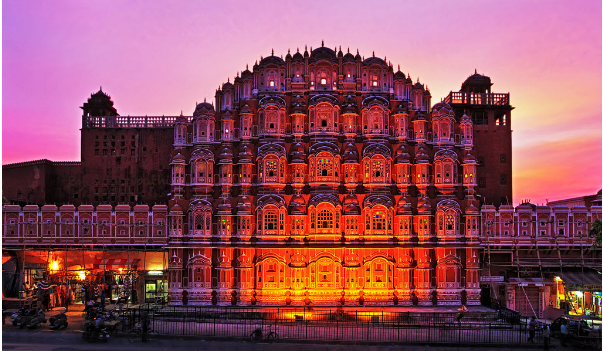Hawa Mahal in Jaipur: Pink City’s Most Iconic Landmark
Hawa Mahal: History
Hawa Mahal, a famous building in Jaipur, is not ordinary. It is 5 floors high and was built in the 18th century. It has beautiful grillworks and a unique facade. People who live in the city and travelers like to see it. It has many decorations and you can see great views from it. Many people want to visit Hawa Mahal at least once in their life. When the moon shines on the city at night, it looks even more beautiful. Visitors are amazed by the view. Don’t forget your camera because every angle of the mahal is worth taking a picture of! If you’re planning to visit Hawa Mahal in Jaipur, Rajasthan Tour Planners is the best travel agency in Rajasthan. The agency can help you have a great trip to see this historic place and other attractions in Rajasthan. They make traveling easy and enjoyable, so you can have a wonderful experience exploring the sights and culture of Jaipur and beyond.
Hawa Mahal Architecture
The story of Hawa Mahal, also known as the Palace of Winds, is exciting. Maharaja Sawai Pratap Singh built it in 1799 for the court harem. They wanted to see the royal processions and the street life. The beautiful palace is made of pink and red sandstone and is known for its amazing architecture. It has 953 windows with intricate jali work.
Maharaja Sawai Pratap Singh’s preferred retreat, the palace, was planned by Lal Chand Usta, an architect. The Hawa Mahal’s design is characterized by its five floors, reaching about 50 feet high. The raised front looks like a honeycomb with small holes, each having tiny windows, carved sandstone grills, and decorative tops. Inside, there are fewer decorations compared to the fancy outside.
The architectural style of Hawa Mahal combines Hindu Rajput and Islamic Mughal influences, which is amazing. Inside, there are big rooms with various colored marbles, panels with inlaid designs, and gold decorations. You enter through a big door into a courtyard with fountains, surrounded by two-story buildings. Each floor of Hawa Mahal has a temple.
A popular place for tourists in Jaipur, this big area has a small museum where people can learn about the history of Hawa Mahal. The museum is well-known for its small paintings and old objects that show the royal history of Rajasthan. From the top of the area, you can see great views of Jantar Mantar, the City Palace, and the Sireh Deori Bazaar.
Hawa Mahal: Today
Today, visiting Hawa Mahal is one of the most interesting things to do in Jaipur because of its beautiful architecture. The Unit Trust of India is helping to take care of this historic building. The Archaeological Department of the Government of Rajasthan controls it. The palace was fixed up in 2006 for about 4.568 million rupees to make it look better.
The nicest time to go to Hawa Mahal is during sunrise and sunset when the sun makes the red and pink building look magical.
Hawa Mahal Museum
In the courtyard of Hawa Mahal, there’s a museum showing old things like antiques and weapons used by the royals. It started in 1983 and lets you see how the royals lived in the past.
Important things to see: Arrow tips, fish hooks, clay items, a pot from the 2nd century, and more.
Here are some facts about Hawa Mahal that many people don’t know:
- Recently, the tourism department put lights on the outside of Hawa Palace to encourage people to visit at night.
- Unlike other palaces, you don’t go in through the front. Instead, there’s a door on the side.
- Maharaja Jai Singh loved Hawa Mahal because it was cool inside and nicely decorated.
- Each of the five floors has a temple. On the first floor is Sharad Mandir, and on the second is Ratan Mandir with colorful glass. The top three floors have Vichitra Mandir, Prakash Mandir, and Hawa Mandir.
- There aren’t any stairs to the upper floors. They made ramps instead so it was easier to carry royal ladies on palanquins.
Best time to visit Hawa Mahal
If you’re planning to go to Hawa Mahal in Jaipur soon, it’s best to go during the winter months from October to March. During this time, the weather is cooler, around 15 to 25 degrees Celsius, and the city is pleasant. You can explore and see the sights without being bothered by the hot temperatures or humidity, which can be uncomfortable during the summer or monsoon seasons.
Nearby tourist spots of Hawa Mahal
Tourist spots near this monument in Jaipur include:
- City Palace
- Jantar Mantar
- Albert Hall Museum
- Nahargarh Fort
- Jaigarh Fort
- Jal Mahal
- Amer Fort
- Birla Mandir (Laxmi Narayan Temple)
- Sisodia Rani Garden
Frequently Asked Questions
What is special about Hawa Mahal?
Hawa Mahal, also known as the “Palace of Winds,” is a unique architectural marvel located in Jaipur, India. Its distinctive feature is its facade adorned with 953 small windows or “jharokhas,” which allow the breeze to flow through the palace, keeping it cool during hot summers. The structure is a fine example of Rajputana architecture and is renowned for its intricate design and historical significance.
Who built Hawa Mahal and in which year?
Hawa Mahal was built in 1799 by Maharaja Sawai Pratap Singh, the ruler of Jaipur at that time. It was designed by Lal Chand Ustad, an architect in the Mughal style, to be an extension of the Jaipur City Palace.
Why does Hawa Mahal have so many windows?
The multitude of windows in Hawa Mahal serves several purposes. Firstly, they allow cool air to circulate through the palace, providing natural ventilation and keeping the interior comfortable, especially during the scorching summers of Rajasthan. Secondly, the windows allowed the royal ladies of the court to observe street festivities and everyday life without being seen themselves, maintaining their privacy in accordance with purdah (seclusion) customs prevalent at the time.
What is the top floor of Hawa Mahal?
The top floor of Hawa Mahal consists of small chambers and balconies adorned with intricate lattice work, providing panoramic views of the cityscape. This uppermost level is where the royal ladies would spend their leisure time, enjoying the cool breeze and observing the bustling city life below while remaining hidden from public view.




